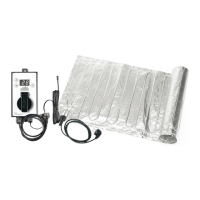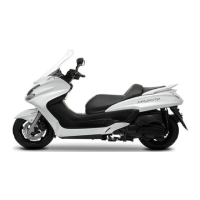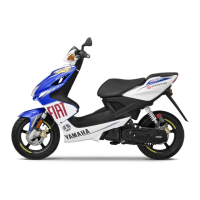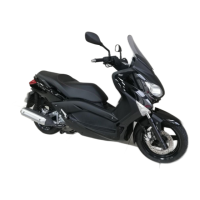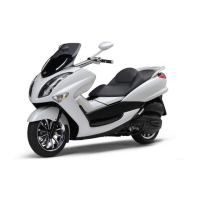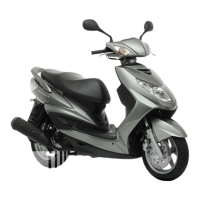Do you have a question about the Yamaha BWS YW100E and is the answer not in the manual?
Displays the vehicle's current speed and distance traveled.
Indicates the amount of gasoline remaining in the fuel tank.
Controls the operation of the scooter's auxiliary, meter, and headlights.
Engages the starter motor to crank the engine for starting.
Lever on the handlebar used to operate the front brake system.
Locations of the fuel and oil reservoirs, typically under the seat.
Part of the fuel system that ensures proper ventilation and operation.
Lever used for manually starting the engine by kicking.
Mechanism for opening and closing the scooter's seat.
Storage compartment, usually located under the seat, with load limits.
Lever that supports the scooter when parked; has an ignition cut-off system.
Procedure for starting the engine when it is cold, including warm-up recommendations.
Guidelines for safe and effective application of front and rear brakes.
Crucial period for new engines to wear in properly, up to 1,000 km.
Safe procedures for parking the scooter, including considerations for hot exhaust.
Description of the tools provided for basic maintenance and repairs.
Schedule outlining routine maintenance jobs based on mileage and time.
Steps to remove the front protection bar and Cowling A for access.
Instructions for removing Panel B to access internal components.
Procedures for removing, inspecting, and replacing the spark plug.
How to measure and adjust the spark plug gap and inspect its condition.
Information on recommended final gear oil and its quantity.
Steps for cleaning the air filter, with emphasis on frequent cleaning in dusty conditions.
Adjusting the throttle cable to ensure proper free play for smooth operation.
Guidance on carburetor adjustment, recommending dealer service for accuracy.
Proper tire inflation pressure based on load for optimal performance and safety.
Guidelines on how to load the scooter to maintain stability and safety.
How to adjust the free play in the front brake lever for correct operation.
How to adjust the free play in the rear brake lever at the brake hub.
Inspecting brake pads and shoes for wear using wear indicators.
Specific instructions for checking the wear limit of the rear brake shoes.
Procedures for replacing brake fluid, recommending trained service personnel.
Inspecting control cables for damage and lubricating them for smooth movement.
Lubricating the pivoting parts of the brake and throttle levers.
Lubricating the pivot points of the center and sidestand for smooth operation.
Inspecting front and rear wheel bearings for play or smooth rotation.
Performing checks on the front fork for damage or unsmooth movement.
Information about the battery, its location, and precautions.
Procedure for replacing blown fuses, with cautions on amperage ratings.
Steps to replace burnt-out turn signal and taillight bulbs.
Instructions for replacing the scooter's license plate light bulb.
Type and total amount of engine oil recommended for the scooter.
Type and total amount of final gear oil required for the scooter.
Type of air filter element used in the scooter.
Recommended type of fuel and the scooter's fuel tank capacity.
Specifications for the scooter's carburetor, including type and quantity.
Details on the recommended spark plug type and its gap.
Type of clutch mechanism used in the scooter.
Identifies the tire manufacturers and models fitted to the scooter.
Recommended tire air pressure settings for different load conditions.
Type of shock absorber system used for front and rear suspension.
Measurement of suspension travel for the front and rear wheels.
Details on the ignition system, charging system, battery, and light bulbs.
Location of the key identification number for reference and key replacement.
Location of the VIN, used for registration and identification purposes.
Displays the vehicle's current speed and distance traveled.
Indicates the amount of gasoline remaining in the fuel tank.
Controls the operation of the scooter's auxiliary, meter, and headlights.
Engages the starter motor to crank the engine for starting.
Lever on the handlebar used to operate the front brake system.
Locations of the fuel and oil reservoirs, typically under the seat.
Part of the fuel system that ensures proper ventilation and operation.
Lever used for manually starting the engine by kicking.
Mechanism for opening and closing the scooter's seat.
Storage compartment, usually located under the seat, with load limits.
Lever that supports the scooter when parked; has an ignition cut-off system.
Procedure for starting the engine when it is cold, including warm-up recommendations.
Guidelines for safe and effective application of front and rear brakes.
Crucial period for new engines to wear in properly, up to 1,000 km.
Safe procedures for parking the scooter, including considerations for hot exhaust.
Description of the tools provided for basic maintenance and repairs.
Schedule outlining routine maintenance jobs based on mileage and time.
Steps to remove the front protection bar and Cowling A for access.
Instructions for removing Panel B to access internal components.
Procedures for removing, inspecting, and replacing the spark plug.
How to measure and adjust the spark plug gap and inspect its condition.
Information on recommended final gear oil and its quantity.
Steps for cleaning the air filter, with emphasis on frequent cleaning in dusty conditions.
Adjusting the throttle cable to ensure proper free play for smooth operation.
Guidance on carburetor adjustment, recommending dealer service for accuracy.
Proper tire inflation pressure based on load for optimal performance and safety.
Guidelines on how to load the scooter to maintain stability and safety.
How to adjust the free play in the front brake lever for correct operation.
How to adjust the free play in the rear brake lever at the brake hub.
Inspecting brake pads and shoes for wear using wear indicators.
Specific instructions for checking the wear limit of the rear brake shoes.
Procedures for replacing brake fluid, recommending trained service personnel.
Inspecting control cables for damage and lubricating them for smooth movement.
Lubricating the pivoting parts of the brake and throttle levers.
Lubricating the pivot points of the center and sidestand for smooth operation.
Inspecting front and rear wheel bearings for play or smooth rotation.
Performing checks on the front fork for damage or unsmooth movement.
Information about the battery, its location, and precautions.
Procedure for replacing blown fuses, with cautions on amperage ratings.
Steps to replace burnt-out turn signal and taillight bulbs.
Instructions for replacing the scooter's license plate light bulb.
Type and total amount of engine oil recommended for the scooter.
Type and total amount of final gear oil required for the scooter.
Type of air filter element used in the scooter.
Recommended type of fuel and the scooter's fuel tank capacity.
Specifications for the scooter's carburetor, including type and quantity.
Details on the recommended spark plug type and its gap.
Type of clutch mechanism used in the scooter.
Identifies the tire manufacturers and models fitted to the scooter.
Recommended tire air pressure settings for different load conditions.
Type of shock absorber system used for front and rear suspension.
Measurement of suspension travel for the front and rear wheels.
Details on the ignition system, charging system, battery, and light bulbs.
Location of the key identification number for reference and key replacement.
Location of the VIN, used for registration and identification purposes.



